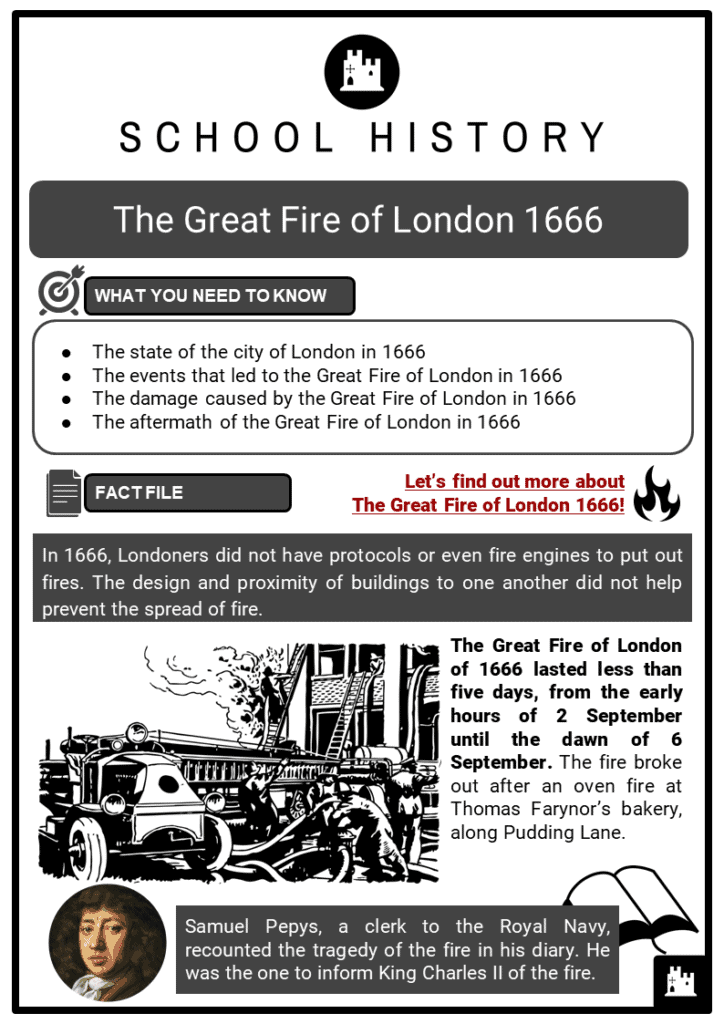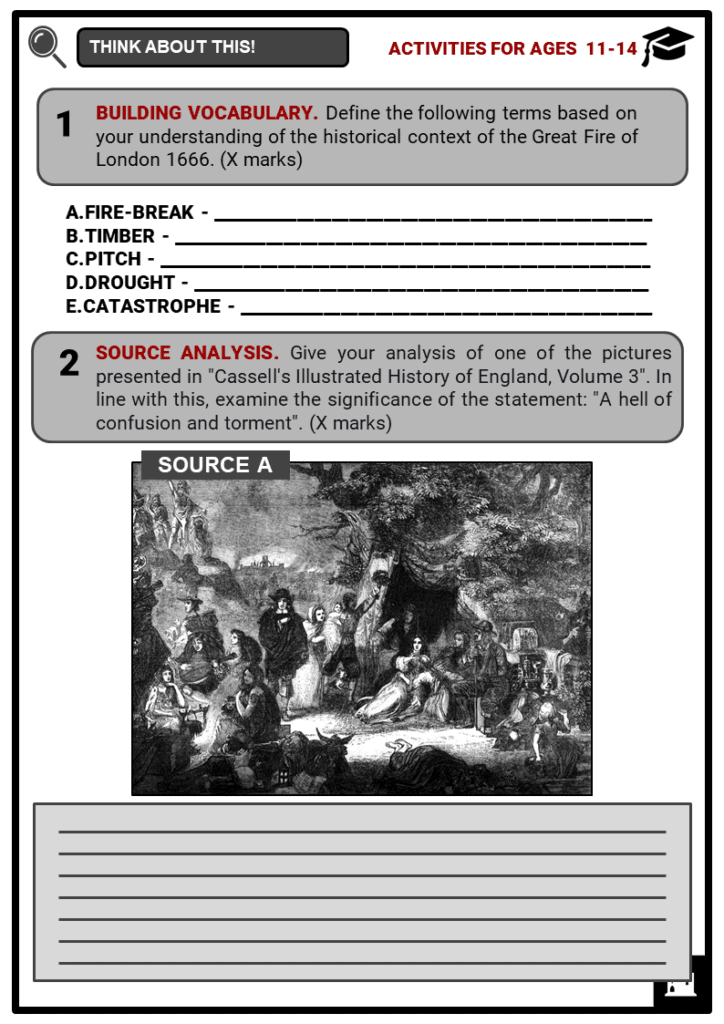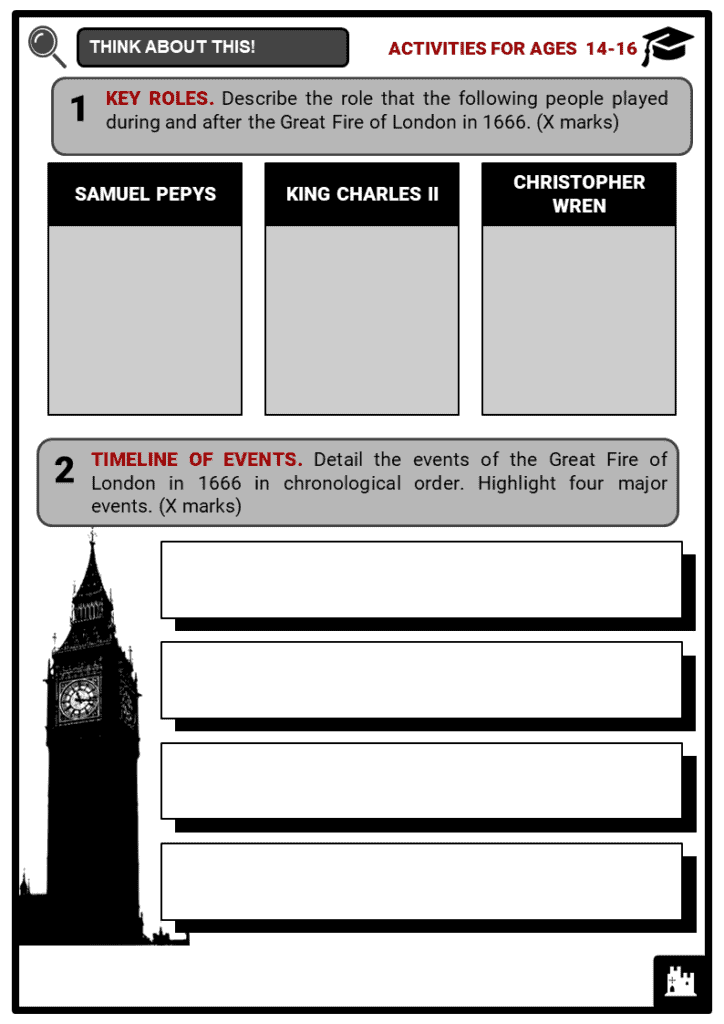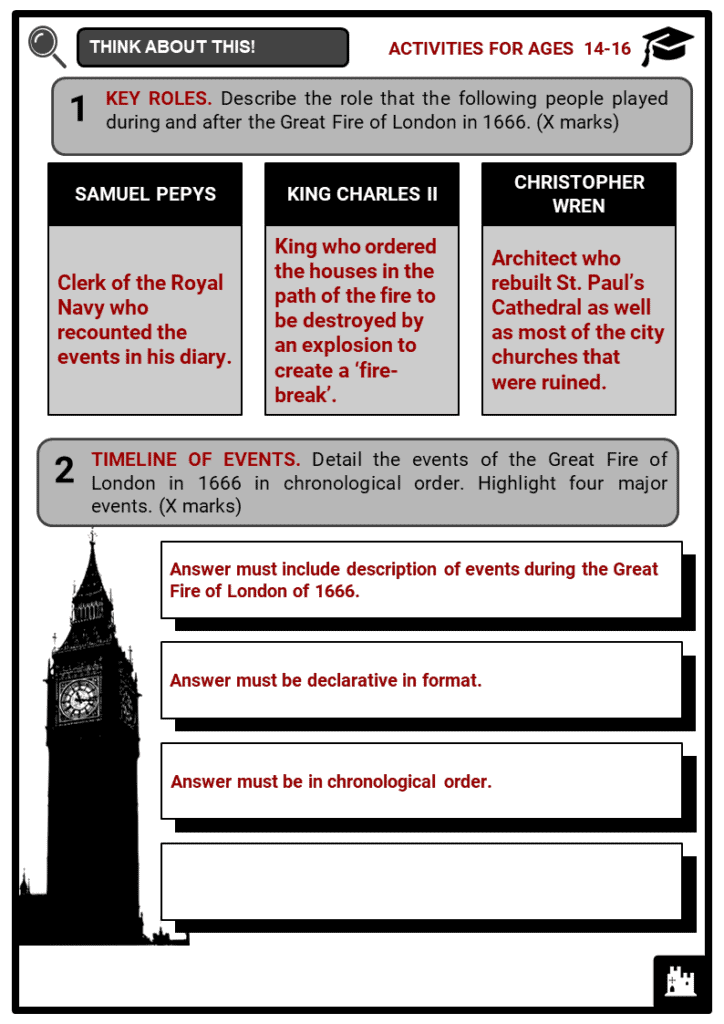Download The Great Fire of London 1666 Worksheets
Do you want to save dozens of hours in time? Get your evenings and weekends back? Be able to teach The Great Fire of London 1666 to your students?
Our worksheet bundle includes a fact file and printable worksheets and student activities. Perfect for both the classroom and homeschooling!
Table of Contents
Add a header to begin generating the table of contents
Summary
- The state of the city of London in 1666
- The events that led to the Great Fire of London in 1666
- The damage caused by the Great Fire of London in 1666
- The aftermath of the Great Fire of London in 1666
Key Facts And Information
Let’s find out more about The Great Fire of London 1666!
- In 1666, Londoners did not have protocols or even fire engines to put out fires. The design and proximity of buildings to one another did not help prevent the spread of fire.
- The Great Fire of London of 1666 lasted less than five days, from the early hours of 2 September until the dawn of 6 September. The fire broke out after an oven fire at Thomas Farynor’s bakery, along Pudding Lane.
- Samuel Pepys, a clerk to the Royal Navy, recounted the tragedy of the fire in his diary. He was the one to inform King Charles II of the fire.
- King Charles II ordered the houses in the path of the fire to be destroyed by an explosion, to create a ‘fire-break’.
- A fire-break is a line created to prevent a fire from spreading.
- A Frenchman named Robert Hubert confessed to starting the Great Fire, and was hanged for it. However, it was later proven that he was not in London when the fire started.
- The cost of the fire ran to 5 to 7 million pounds and saw 13,000 houses, 90 churches and 44 livelihood companies ruined.
- The Royal Exchange, the Guildhall (the offices of the Lord Mayor), and the old St. Paul’s Cathedral were the most important landmarks destroyed.
- Architect Sir Christopher Wren rebuilt St. Paul’s Cathedral as well as most of the city’s churches.
- It took nearly 50 years to rebuild London, but with new regulations on house designs and infrastructures, it became one of the most organised and safest cities in the world.
London in 1666
- London in 1666 was the centre of England’s trade and finance, as it is today. It was also one of the largest cities in Europe with 350,000 people.
- As there were no cars, buses, or lorries, the city was full of sheds and yards packed with hay and straw for people’s primary mode of transportation and livelihood - animals.
- Most buildings were made of timber, covered with pitch, a flammable substance that keeps wooden materials together.
- Thatch, which is made of straw, reeds, or palm leaves, covered the roofs, and the houses were packed together without proper planning.
- At the time of the great fire, London had also just gone through summertime which caused a severe drought in the city. The shortage in water supply and the proximity of the buildings to one another were the main contributing factors to the spread of the fire which lasted for under five days and destroyed the majority of the city.
The Fire
- The fire started at Pudding Lane, in Thomas Farynor’s bakery at 1am on 2 September, 1666. It lasted until 6 September, making it the longest fire ever in London.
- It was believed that a stray of ember from Farynor’s oven had ignited a pile of twigs that were had been overlooked. The fire spread incredibly quickly from house to house
as they were extremely close together. - Many Londoners fled to the River Thames and tried to load their goods onto boats to get away to safety.
- Others rushed through the city gates and went to the fields outside London.
- A significant historic account of the fire came from the diary of a clerk to the Royal Navy, Samuel Pepys. He was also a Londoner who witnessed the destruction of his beloved city, recalling that “it made me weep to see it” in one of his entries.
- Pepys was the one to travel to the Palace of Whitehall to inform the then King Charles II about the fire and to suggest a possible way to stop it from spreading.
- After hearing of the plan, King Charles II sent the Duke of York with the army to bomb a row of houses and buildings before the fire reached it. Pepys also wrote that even the king was seen helping put out the fire.
How did it start ?
- The fire started when some hot coals fell out of a bakers oven.
- Straw was on the floor and soon set alight
- This happened at night and the fire soon spread
- The baker was the Kings Baker. His name was Thomas Farrinor The shop was on Pudding Lane
When did it start ?
- It started at 2 am on the 2nd of September 1666 and ended four days later, 6th September 1666.
Why did it spread so quickly ?
There were lots of reasons
- It had been another long hot summer and everything was very dry
- Most houses were made from wood—so they burned easily
- Most of the houses were very close together—so the fire spread quickly
- Near where the fire started there were warehouses with flammable things like tar and rope.
- Houses did not have running water. Water was came from pumps in the streets. The water
- pump near where the fire started was out of order.
- There was also a drought due to the hot weather—everything was very dry
- There was no fire brigade. All people could use were leather buckets and water squirts. 8) The wind was blowing towards the most densely (heavily) populated part of London.
How did they try to put the fire out ?
- To begin with the Lord Mayor of London did very little. Fires were common on London at this time.
- The Mayor felt the fire at first was nothing unusual—and would soon go out
- The fire soon got out of control
- Buckets and hand powered water squirts were used but they were not enough.
- Firebreaks were tried – this was when the king ordered that certain houses be pulled down to create a break in the fire.
Why did the fire go out ?
- The wind changed direction—and blew the fire towards the stone parts of the city—slowing it down.
- The weather got cooler
- The firebreaks slowed it down – with the help of the army !
What were the consequences (effects) of the fire ?
- It destroyed about 80 % of London.
- The Great Fire destroyed about 13,200 houses, 84 parish churches, and the old St. Paul’s Cathedral.The Cathedral was rebuilt by Sir Christopher Wren
- Less than 10 people died (we think 6 died), but thousands were made homeless
- The fire had destroyed a dangerous and unhealthy area of London, and new buildings of brick andstone replaced the wooden houses these were a lot cleaner.
- Houses were built wider apart.
How do we know about the fire of London and the plague?
- Parish records give us some information on both of theses events.
- One of the best sources of information is Samuel Pepys. He lived through both the fire and the plague and he kept a dairy.
Why did some people blame the fire on a catholic plot ?
- Shortly after the fire started a man called Robert Hubert said he started the fire. He was a Catholic
- Hubert wasn’t even in the country when the fire started and he was mentally ill. But he was executed any way
The Aftermath
- A total of 13,000 houses, 90 churches, and 44 livelihood companies were burned in the fire.
- The Royal Exchange, the Guildhall (the offices of the Lord Mayor), and the old St. Paul’s Cathedral were also destroyed.
- Hundreds of people were left homeless, but only six people died.
- The total property loss was estimated at 5 to 7 million pounds.
Rebuilding London
- After the five-day fire, one third of London was destroyed. Although considered a catastrophe, many believed that the fire cleansed the city from the overcrowded and disease-ridden streets.
- On the spot where the fire began in Pudding Lane, a monument was erected, which can still be seen today. It took nearly 50 years to rebuild London. Sir Christopher Wren, an English architect, was tasked to lead the reconstruction of most of the city. London, as it is known today, was mostly his design.
- His masterpiece, St. Paul’s Cathedral, was started in 1675 and completed in 1711. He also rebuilt 52 of the city churches, and his map to rebuild London remains to be one of the most historic and elaborate design plans ever created. To prevent such tragedy from happening again, new regulations were designed in London. Instead of wood, houses had to be made from brick now. Most streets were widened, pavements and new sewers were laid, and London’s quaysides were improved.






